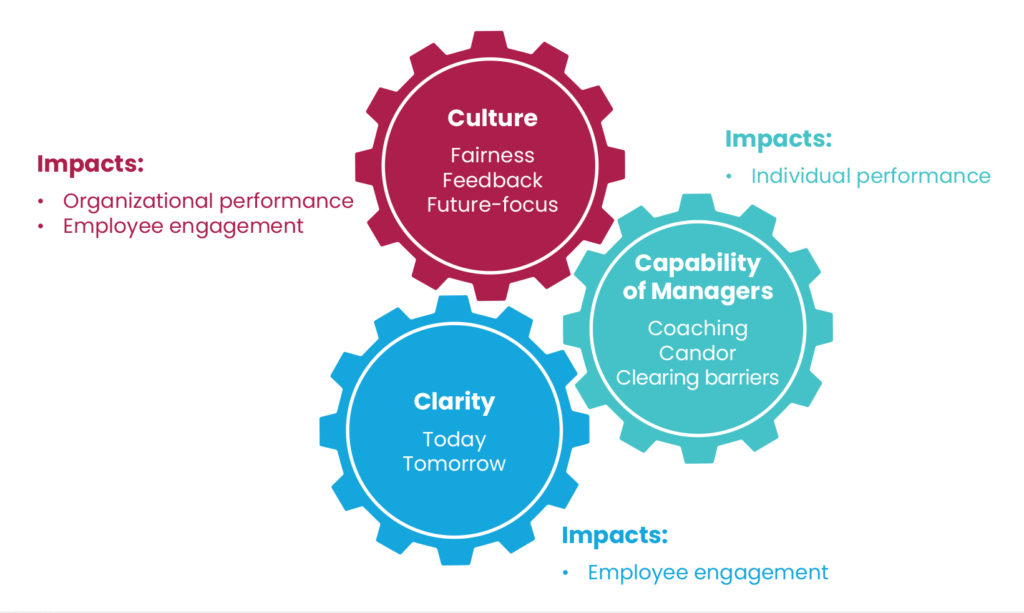Clearing Barriers: Tips for a Key Manager Capability
October 22nd, 2019
In our research, The Makings of Modern Performance Management, we identified 3 levers of modern performance management (see Figure 1). In the course of 2 roadshows we’ve done since publishing the research, we’ve received a number of questions about one item in particular:
How can managers clear barriers for their employees?
We thought we’d take a few minutes to share with you a bit of additional information, in case you are also asking yourself this question.

Figure 1: Three Levers of Modern Performance Management | Source: RedThread Research, 2019.
You see a mountain, I see a mole hill
One of the first steps for managers is to align with their direct reports on what barriers they are facing in the first place. For example, a direct report might see a major, overwhelming amount of work on their plate, whereas a manager may simply see a need to prioritize better. Therefore, a great first step is for managers is to include pretty simple question during their check-in conversations:
What obstacles are you facing and how can I help remove them?
This is similar to what happens at Intermountain Healthcare, a Utah-based, not-for-profit hospital system, where managers are encouraged to cover 3 types of discussions during their check-in conversations:
- Connecting and removing barriers
- Contribution towards results
- Growth and development
Now, of course, the manager then needs to know how to respond appropriately – and specifically to understand when it is a barrier that only they can remove or if it's one that their employee needs help figuring out how to address for themselves. This type of insight is usually the result of managers using a coaching mindset – which they may have to learn through some form of learning and development resources. It's important that organizations offer these resources for managers to better understand how to coach their employees and that the organizational culture and organizational incentives then reinforce those behaviors.
Build barrier-busting mindsets
Once managers and employees have sorted out which barriers need to be broken down by whom, it is up to the manager to empower their employees to do their part. Organizations should provide a clear framework of when and how to escalate issues, to that employees know which problems they should tackle on their own.
In addition, managers need to encourage employees to find and document solutions to common problems. For example, if a certain type of email has to be sent out regularly, that should be kept in a central repository for everyone to access it (yes, we know this sounds simple, but this is the stuff of which barrier-busting is made). In addition, managers need to reinforce to employees that they will not be penalized for trying to break down major barriers if, for some reason, the effort goes awry. It’s critical that when managers ask employees to drive and own change, that they believe they are in a psychologically safe environment to do so.
Bust barriers, manager style
Finally, it's up to the manager to bust down some of those barriers themselves. The first step here is for managers to look at themselves and determine the activities or expectations they may have put in place that could be causing barriers.
For example, take the all-team meeting. Depending on the size of the team, it may not be terribly useful for everyone. However, no one is going to tell the manager that they shouldn’t have that meeting, even though it is largely a waste of time. It is on the manager to instead make sure that meetings have a clear objective that couldn’t be achieved without the meeting – and to then fix things when that isn’t the case.
Another example is when managers have put in place processes or expectations that are causing barriers to working being done effectively. Again, managers need to create a psychologically safe environment that allows employees to let them know when something could be improved – and to then not react negatively when it does.
Managers need to look outside themselves, and determine how they can help remove organizational barriers for employees. It might be laying the groundwork for an employee’s initiative or working with other leaders at their level to address a specific challenge. Another, absolutely critical manager task, is managers helping employees build the networks they need to solve their own problems. You likely know of other ways to break down barriers for employees – and we’d love to hear them! Please share them in the comments or give us some feedback on what you read here today.
Also, please have a look at our report, in which we dive into each lever in our model in detail and provide examples of how organizations bring them to life.